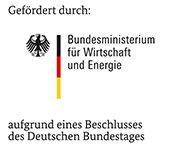358 ZN

| Period: | 01.06.2010 - 30.11.2012 |
|---|---|
| Funder: | AiF |
| Project Manager: | M.Sc. Dominik Tabatabai |
| Research Group: | Corrosion |
Aim
The application of magnesium alloys is decisively limited by their high susceptibility to corrosion. For corrosion protection chromating has been the surface treatment of choice for a long time. The coatings generated hereby exhibit self-healing properties, providing sustainable corrosion protection. Since chromate coatings have been banned in the European Union for their impact on health and environment there is an increased demand for alternative, harmless surface treatments which offer comparable or superior corrosion protection. The aim of this project is the development of corrosion protection coatings for wrought magnesium alloys which feature self-healing properties. Furthermore, the process shall be cost-effective and environment-friendly.
Approach
Corrosion protection by the new protective layers shall be based on three elements:
1. an anodizing layer 2. encapsulated corrosion inhibitors 3. encapsulated momoners which are capable of forming hydrophobic SAMs (self-assembling monolayers)
The anodizing layer directly contributes to corrosion protection by acting as a physical barrier. Furthermore, it serves as a matrix for the incorporation of encapsulated corrosion inhibitors and encapsulated SAM monomers. For the purpose of cost-reduction an anodizing process has to be chosen that allows the development of protective layers with sufficient resistance towards corrosion even when relatively low voltages are applied. Furthermore, substances which may pose a serious threat to health and environment like CrIV compounds are to be avoided.
Encapsulated corrosion inhibitors shall be incorporated into areas of the anodizing layer near to the substrate. In case of corrosion the inhibitors shall be released by the capsules in a target-oriented and controlled way and prevent further corrosion. Compounds of rare earth elements, amongst others, are considered as corrosion inhibitors. For the encapsulation of the inhibitors micro- and mesoporous nanoparticles are considered. While many zeolites are cation exchangers and can thus directly be loaded with rare earth cations, silica based mesoporous particles should undergo a chemical surface modification in order to enhance their affinity towards cations.
Encapsulated SAM monomers are to be incorporated into areas near to the surface of the anodizing layer. If the anodizing layer is damaged, monomers shall be locally released and form hydrophobic monolayers. This shall prevent the intrusion of aggressive and corrosion promoting ions into the anodizing layer. Long-chain carbonic acids, phosphonic acids or sulphonic acids should qualify for this application. Again, for their encapsulation the use of surface modified mesoporous nanoparticles is considered.
Results
Anodizing layers which were generated in KOH solutions of varying cocentrations between 0.3 mol/L and 3.0 mol/L showed a decrease in their growth rates with decreasing electrolyte concentration. However, all layers showed a comparable improvement of their corrosion resistance compared to non-anodized samples in potentiodynamic polarization experiments.
We tried to incorporate compact silica nanoparticles into the anodizing layers, which should serve as a cost-efficient model for micro- or mesoporous nanoparticles. Instead of developing two separate procedures for the generation of the anodizing layer and the following incorporation of nanoparticles, we followed an approach which should allow the continuous incorporation of the nanoparticles during the growth of the anodizing layer. For this the nanoparticles were dispersed in the alcaline electrolyte solution before the anodizing process. Cross section polishes of the resulting anodizing layers were characterized by WDX measurements with respect to their element distribution. A rather homogeneous distribution of silicon throughout the whole anodizing layer was found. The amount of incorporated silicon could be raised by reducing the concentration of the anodizing electrolyte.
Furthermore, the loading of mesoporous nanoparticles with rare earth cations and their subsequent release were investigated. The loading capacity of mesoporous nanoparticles for Eu3+ could be significantly enhanced by modifying the particle surface with a functional group. AAS measurements showed that the Eu3+ cations are selectively released under acidic conditions.
A screening of carboxylic and phosphonic acids of various chain lengths revealed that the monolayers formed on AZ31 by phosphonic acids are generally more hydrophobic and more stable than those formed by carboxylic acids. Hydrophobicity and stability of the monolayers rise with increasing chain length.
Future work
We have yet to verify the constitution of the silica species that is incorporated in the anodizing layers. After that inhibitor-filled nanoparticles are to be incorporated in anodizing layers. The self-healing properties of the resulting layers are to be investigated by long term exposure tests and electrochemical methods. Furthermore, long chain phosphonic acids are yet to be encapsulated in surface-modified, mesoporous SiO2 particles.
back

Das IGF-Vorhaben Nr. 358 ZN der Forschungsvereinigung DECHEMA e.V., Theodor-Heuss-Allee 25, 60486 Frankfurt am Main wurde über die AiF im Rahmen des Programms zur Förderung der industriellen Gemeinschaftsforschung (IGF) vom Bundesministerium für Wirtschaft und Energie aufgrund eines Beschlusses des Deutschen Bundestages gefördert.
Contact |
| Prof. Dr.-Ing. Wolfram Fürbeth |
| Tel.: +49 69 / 75 64-398 E-mail: fuerbeth |
Publications |
| D. Tabatabai, F. Feil, G. Grundmeier, P. Thissen, W. Fürbeth in: K.U. Kainer (Hrsg.), Magnesium, Wiley-VCH, Weinheim (2009) 980-985 |